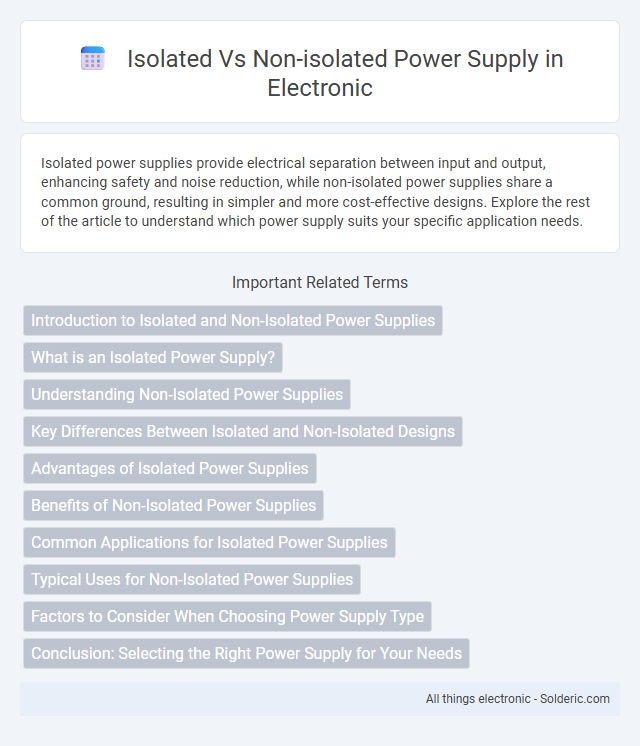Isolated power supplies provide electrical separation between input and output, enhancing safety and noise reduction, while non-isolated power supplies share a common ground, resulting in simpler and more cost-effective designs. Explore the rest of the article to understand which power supply suits your specific application needs.
Comparison Table
| Feature | Isolated Power Supply | Non-Isolated Power Supply |
|---|---|---|
| Electrical Isolation | Yes, provides galvanic isolation between input and output | No, input and output share a common ground |
| Safety | Higher safety, protects against electric shock and surges | Lower safety, higher risk of ground loops and shock |
| Application | Medical devices, industrial equipment, sensitive electronics | Low-power electronics, cost-sensitive designs |
| Cost | Higher cost due to isolation components like transformers | Lower cost, simpler design |
| Size & Weight | Usually larger and heavier | Compact and lightweight |
| Noise Immunity | Better noise rejection and EMI reduction | Less effective noise filtering |
| Complexity | More complex circuit design | Simple circuit design |
| Efficiency | Generally lower efficiency due to isolation losses | Higher efficiency |
Introduction to Isolated and Non-Isolated Power Supplies
Isolated power supplies provide electrical separation between input and output circuits using transformers or optocouplers, enhancing safety and reducing noise interference. Non-isolated power supplies share a common ground between input and output, resulting in a more compact design with higher efficiency but lower protection against electrical faults. Choosing between isolated and non-isolated power supplies depends on application requirements such as safety standards, noise sensitivity, and system complexity.
What is an Isolated Power Supply?
An isolated power supply is a type of electrical power system where the output is electrically separated from the input, typically using a transformer to provide galvanic isolation. This isolation enhances safety by preventing direct current flow between input and output circuits, reducing the risk of electric shock and minimizing noise interference in sensitive electronic devices. Understanding the role of isolated power supplies is crucial for protecting your equipment and ensuring stable, reliable power delivery in medical devices, industrial systems, and communication networks.
Understanding Non-Isolated Power Supplies
Non-isolated power supplies share a common ground between input and output, allowing efficient energy transfer with minimal components. They are typically used in low-voltage applications such as DC-DC converters within battery-powered devices. Non-isolated designs offer cost-effective solutions but lack galvanic isolation, making them unsuitable for applications requiring enhanced safety or noise immunity.
Key Differences Between Isolated and Non-Isolated Designs
Isolated power supplies feature galvanic separation between input and output, enhancing safety and reducing noise interference in sensitive electronics, whereas non-isolated designs share a common ground, offering simpler circuits and higher efficiency at the cost of reduced protection. You choose isolated power supplies for applications demanding high voltage isolation and noise immunity, while non-isolated types suit low-voltage, cost-sensitive uses. Key parameters include isolation voltage rating, efficiency, size, and complexity, which directly impact performance and design considerations.
Advantages of Isolated Power Supplies
Isolated power supplies offer enhanced safety by preventing direct electrical connection between input and output, reducing the risk of electric shock and equipment damage. They improve noise immunity and signal integrity, making them ideal for sensitive electronic devices and medical equipment. Isolation also enables multiple circuits to operate independently without interference, facilitating safer and more reliable system designs.
Benefits of Non-Isolated Power Supplies
Non-isolated power supplies offer increased efficiency and lower cost by eliminating isolation transformers, making them ideal for applications where ground reference unity is essential. These power supplies provide simpler circuit designs and reduced size and weight, enhancing system integration and reliability. Your choice of non-isolated power supplies supports fast transient response and efficient power conversion in low-voltage, tightly regulated environments.
Common Applications for Isolated Power Supplies
Isolated power supplies are widely used in medical devices, industrial automation, and telecommunications to prevent electrical noise and enhance safety by separating the input and output circuits. These power supplies provide effective protection against voltage spikes and ground loops, making them essential for sensitive equipment and hazardous environments. Their ability to deliver clean, stable energy helps maintain signal integrity and compliance with stringent regulatory standards in critical applications.
Typical Uses for Non-Isolated Power Supplies
Non-isolated power supplies are commonly used in applications where the input and output share a common ground, such as in low-voltage DC power conversion for embedded systems, LED drivers, and battery chargers. These power supplies provide efficient energy transfer when electrical isolation is not required, offering simpler design and cost advantages. Your choice of a non-isolated power supply suits environments where safety isolation between input and output circuits is unnecessary.
Factors to Consider When Choosing Power Supply Type
Efficiency requirements, safety standards, and application environment are critical factors when choosing between isolated and non-isolated power supplies. Isolated power supplies offer enhanced protection against electrical noise and ground loops, making them ideal for sensitive medical or industrial equipment, while non-isolated power supplies provide compact design and higher efficiency suitable for low-voltage, cost-sensitive applications. Voltage levels, regulatory compliance, and physical size constraints also influence the selection process for optimal performance and system reliability.
Conclusion: Selecting the Right Power Supply for Your Needs
Choosing between isolated and non-isolated power supplies depends on application requirements such as safety, noise sensitivity, and system complexity. Isolated power supplies offer enhanced protection and noise immunity by electrically separating input and output, ideal for sensitive instrumentation and medical devices. Non-isolated power supplies provide higher efficiency and lower cost, suitable for less critical applications where isolation is not a priority.
isolated vs non-isolated power supply Infographic

 solderic.com
solderic.com